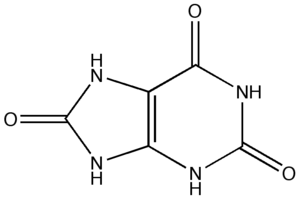Hyperuricosuria
Hyperuricosuria is a medical term referring to the presence of excessive amounts of uric acid in the urine. For men this is at a rate greater than 800 mg/day, and for women, 750 mg/day.[1] Notable direct causes of hyperuricosuria are dissolution of uric acid crystals in the kidneys or urinary bladder, and hyperuricemia. Notable indirect causes include uricosuric drugs, rapid breakdown of bodily tissues containing large quantities of DNA and RNA, and a diet high in purine.
| Hyperuricosuria | |
|---|---|
 | |
| Uric acid | |
| Specialty | Nephrology, urology |
Drugs that may contribute to the cure or amelioration of hyperuricosuria include allopurinol which acts by inhibiting xanthine oxidase and reducing uric acid production.[2]Hyperuricosuria may be a medical sign of:
- Gout (very common)
- Kidney stones of uric acid (uric acid nephrolithiasis)
- Acute uric acid nephropathy
- Acute renal failure
- Tumor lysis syndrome
- Fanconi syndrome
- Dent's disease (very rare)
Classification
Acute hyperuricosuria is a common complication of tumor lysis syndrome. This syndrome appears not to contribute to gout and to uric acid nephrolithiasis, which is evidence that these two conditions have chronic, not acute, causes.
Chronic hyperuricosuria is associated with gout and uric acid nephrolithiasis. However, both conditions can occur in the absence of hyperuricosuria. Treatment of gout with uricosuric drugs can lead to uric acid nephrolithiasis.
Treatment
If neither hyperuricemia nor gout is present, then the risk of uric acid nephrolithiasis can be reduced by the use of antiuricosuric drugs. One should also consider eating a low purine diet. Additionally, making the urine pH more alkaline is protective.[3]
References
- "Hyperuricosuria and Gouty Diathesis". Medscape, WebMD Ltd. 2016. Retrieved 1 April 2013.
- "Allopurinol". MedlinePlus, National Library of Medicine, US National Institutes of Health. 2016. Retrieved 24 December 2016.
- Mattle D, Hess B (May 2005). "Preventive treatment of nephrolithiasis with alkali citrate--a critical review" (PDF). Urol. Res. 33 (2): 73–9. doi:10.1007/s00240-005-0464-8. PMID 15875173.